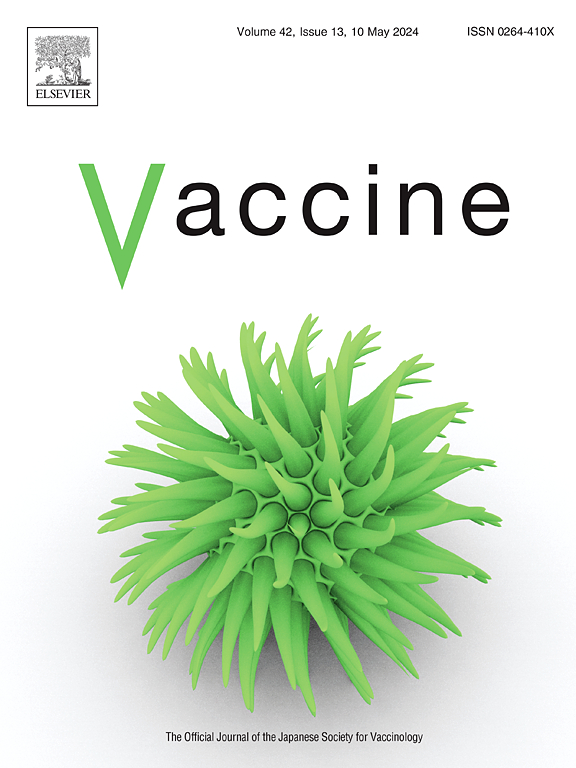Nontoxic, multi-domain botulinum neurotoxin-LCHCN as vaccines against botulism.
IF 4.5
3区 医学
Q2 IMMUNOLOGY
引用次数: 0
Abstract
Botulinum neurotoxins (BoNTs), the causative agents of botulism, are proteins consisting of an N-terminal catalytic Light Chain (LC) and a C-terminal Heavy Chain (HC), which comprises a LC-translocation domain (HCN) and a receptor binding domain (HCC). There are seven BoNT serotypes (A-G) and multiple subtypes. Currently, there is no approved vaccine against botulism available for human use. Several studies have investigated BoNT domains, multi-domains, or mutated holotoxins as candidate BoNT vaccines. However, residual toxicity has been observed in mutated full-length BoNTs and multi-domain (LCHCN) vaccines. In this study, six-individual point substitutions (6M) were introduced into the substrate binding and cleavage sites, zinc binding motif, and LC translocation region of LCHCN/A1 and LCHCN/B1, which possessed no detectable toxicity in mice at 200 μg, being >40-million-fold less toxic than full-length BoNT. IP immunization of mice with 6MLCHCN/A1 or 6MLCHCN/B1 elicited a strong IgG response that protected against high dose challenge with BoNT/A1 or BoNT/B1, respectively. 4MBoNT/B1 and 7MBoNT/B1 were also engineered and found to elicit strong IgG responses that protected against high dose challenge with BoNT/B1. Thus, multi-domain inactivation may yield potent and safe vaccines against other BoNT-serotypes and BoNT-like proteins. The strategy of systematic inactivation of multiple functional domains by targeted single amino acid substitutions to decrease toxicity, combined with investigations of the most immunogenic and protective domains, provides a robust platform for protein toxin vaccines for humans and animals.
无毒,多结构域肉毒杆菌神经毒素- lchcn作为肉毒杆菌中毒疫苗。
肉毒杆菌神经毒素(BoNTs)是肉毒中毒的病原体,是由n端催化轻链(LC)和c端重链(HC)组成的蛋白质,其中包括LC易位结构域(HCN)和受体结合结构域(HCC)。BoNT有7种血清型(A-G)和多种亚型。目前,还没有经批准的肉毒杆菌疫苗可供人类使用。一些研究已经调查了BoNT结构域、多结构域或突变的全毒素作为BoNT候选疫苗。然而,在突变的全长bont和多结构域(LCHCN)疫苗中观察到残留毒性。本研究在LCHCN/A1和LCHCN/B1的底物结合和裂解位点、锌结合基元和LC易位区引入6个单点取代(6M),在200 μg下对小鼠没有检测到毒性,毒性比全长BoNT低4000万倍。6MLCHCN/A1或6MLCHCN/B1的IP免疫小鼠可引起强烈的IgG应答,分别保护小鼠免受BoNT/A1或BoNT/B1的高剂量攻击。4MBoNT/B1和7MBoNT/B1也经过工程设计,并发现可引起强烈的IgG反应,可防止BoNT/B1的高剂量攻击。因此,多结构域失活可以产生针对其他bont血清型和bont样蛋白的有效和安全的疫苗。通过靶向单氨基酸取代系统地失活多个功能域以降低毒性的策略,结合对最具免疫原性和保护性结构域的研究,为人类和动物的蛋白质毒素疫苗提供了一个强大的平台。
本文章由计算机程序翻译,如有差异,请以英文原文为准。
求助全文
约1分钟内获得全文
求助全文
来源期刊

Vaccine
医学-免疫学
CiteScore
8.70
自引率
5.50%
发文量
992
审稿时长
131 days
期刊介绍:
Vaccine is unique in publishing the highest quality science across all disciplines relevant to the field of vaccinology - all original article submissions across basic and clinical research, vaccine manufacturing, history, public policy, behavioral science and ethics, social sciences, safety, and many other related areas are welcomed. The submission categories as given in the Guide for Authors indicate where we receive the most papers. Papers outside these major areas are also welcome and authors are encouraged to contact us with specific questions.
 求助内容:
求助内容: 应助结果提醒方式:
应助结果提醒方式:


